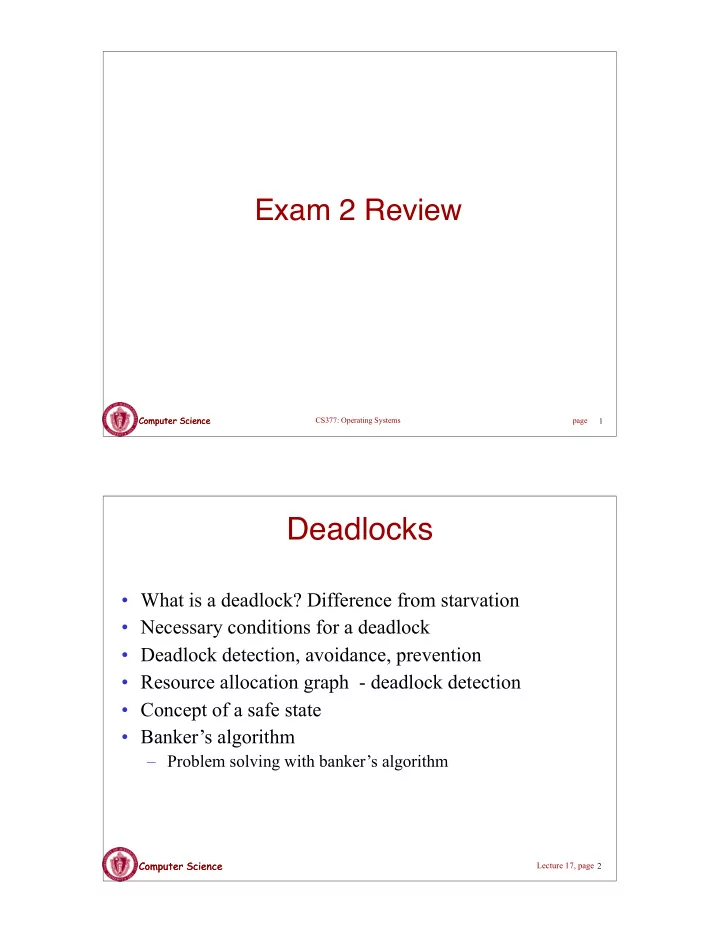

Exam 2 Review Computer Science Computer Science CS377: Operating Systems page 1 Deadlocks • What is a deadlock? Difference from starvation • Necessary conditions for a deadlock • Deadlock detection, avoidance, prevention • Resource allocation graph - deadlock detection • Concept of a safe state • Banker’s algorithm – Problem solving with banker’s algorithm Computer Science Computer Science Lecture 17, page 2
Memory Management Topics you should understand: 1. What is virtual memory and why do we use it? 2. Memory allocation strategies: – Relocation and Contiguous allocation (first-fit and best-fit algorithms) – Paging – Segmentation – Paged segmentation – Demand paging Computer Science Computer Science CS377: Operating Systems Lecture 17, page 3 Memory Management (cont.) For each strategy, understand these concepts: • Address translation • Hardware support required • Coping with fragmentation • Ability to grow processes • Ability to share memory with other processes • Ability to move processes • Memory protection • What needs to happen on a context switch to support memory management Computer Science Computer Science CS377: Operating Systems Lecture 17, page 4
Memory Management (cont.) Things you should be able to do: • Given a request for memory, determine how the request can be satisfied using contiguous allocation. • Given a virtual address and the necessary tables, determine the corresponding physical address. Computer Science Computer Science CS377: Operating Systems Lecture 17, page 5 Memory management strategies • Contiguous allocation – Static versus dynamic allocation – Base and limit registers – Best, first, worst-fit strategies Computer Science Computer Science Lecture 17, page 6
Paging and Segmentation Topics you should understand: • What is paging, a page, a page frame? • What does the OS store in the page table? • What is a TLB? How is one used? – Effective memory access times using a TLB • What is segmentation? where are segment tables stored? • How to combine segmentation and paging? • What is demand paging? • What is a page fault, how does the OS know it needs to take one, and what does the OS do when a page fault occurs? Computer Science Computer Science CS377: Operating Systems Lecture 17, page 7 Paging (cont.) • Page replacement algorithms. For each understand how they work, advantages, disadvantages, and hardware requirements. 1. FIFO 2. MIN 3. LRU 4. Second chance 5. Enhanced second chance • How do global and per-process (aka local) allocation differ? • What is temporal locality? What is spatial locality? What effect do these have on the performance of paging? • What is a working set? Computer Science Computer Science CS377: Operating Systems Lecture 17, page 8
Paging (cont.) • What is thrashing and what are strategies to eliminate it? • What considerations influence the page size that should be used? Things you should be able to do: 1. Given a page reference string and a fixed number of page frames, determine how the different replacement algorithms would handle the page faults. Computer Science Computer Science CS377: Operating Systems Lecture 17, page 9
Recommend
More recommend